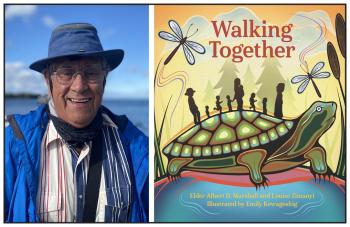Image Caption
Summary
Local Journalism Initiative Reporter
Windspeaker.com
Mi’kmaq Nation Elder and spiritual leader Albert D. Marshall’s first foray into children’s picture books as a co-author is an example of the concept of etuaptmumk or two-eyed seeing.
Etuaptmumk is about using one eye or lens to look at the world through your own language and culture, Marshall explains, and using your other eye or lens to “seek other perspectives to help you.”
“If anyone is going to apply the two-eyed seeing, it has to become action-oriented because something’s got to be added on to it, (on to) a concept or a phrase or an action,” said Marshall, a member of the Eskasoni First Nation in Unama’ki-Cape Breton.
Twenty-five years ago Marshall employed etuaptmumk as a way for Indigenous youth to “embrace all knowledges” without losing their traditional knowledge as they interacted in the western world.
To the youth, he said, “It’s incumbent upon you now to take the best from whatever the Eurocentric system has brought forth, and you have the best from your culture perspective. And if you put those two best ways of knowing together, you’ll be much richer. You’ll have a better chance of not just understanding but also meeting the challenges, wherever those challenges may come from.”
Marshall joined forces with Louise Zimanyi, a professor and researcher of French-Canadian and Hungarian descent, to write Walking Together. Zimanyi’s work explores earth-centred pedagogy and practise for long-term sustainability of the environment.
“(With) two-eyed seeing, we have to integrate other ways of knowing. By working with another person that’s not from the Aboriginal side, that presents the mainstream…we started those discussions a way back (of) what do we need if people are disconnected from nature?” said Marshall.
Through the use of vibrant colours and captions in English, with a smattering of Mi’kmaq and Anishinaabemowin words, Walking Together focuses on the reciprocal relationship that exists between people and the land.
“As we have now been attempting to revitalize all aspects of our culture, life, and if we’re going to do a good job on the language, it cannot be done without the knowledge of the natural world,” said Marshall.
The book is developed and drawn for children ages four to seven years because, he points out, the majority of the Indigenous population is young.
“So ideally picking something in which we can start from the way, way, way bottom because appreciating nature and respecting nature, starting…at early childhood development and onward…this experience becomes part and parcel of their lives,” said Marshall.
Keeping the text to a minimum was also important, he says, because “if you include more visuals than the actual text, you’re actually generating numerous stories because each illustration would generate so many stories. It depends upon who’s looking at it.”
Marshall says there was much conversation that went on between him and Zimanyi with Anishnaabe artist and illustrator Emily Kewageshig to determine the perfect illustrations for each page.
Today, two-eyed seeing is becoming a more common approach initiated by the western world in its interactions with Indigenous communities, particularly in the area of science, such as medical research and the environment.
“That was something that was absent and missing previously. There has been very, very limited effort put forth of, not just in hearing our stories, but actually integrating our ways of being, our ways of knowing into the system. We felt very deprived,” said Marshall.
It’s taken almost three decades for that change, but Marshall says it makes him hopeful that the western world will come to understand that “our ancestors could co-exist in this complex system called environment without them ever compromising the integrity of the areas in any era. We felt that there were lessons there that could be brought forward to the present that hopefully others can embrace, so we can all be doing the same thing: Taking care of our environment.”
Walking Together delivers that message.
“Hopefully this book here will somehow resonate in the minds of the not just Aboriginal people but all people about how much we are part and parcel of the wonderful creation,” said Marshall.
Walking Together is published by Annick Press and can be purchased in bookstores and online.
Never miss a Windspeaker article. Subscribe Today to our new Windspeaker Newsletter!
Local Journalism Initiative Reporters are supported by a financial contribution made by the Government of Canada.

